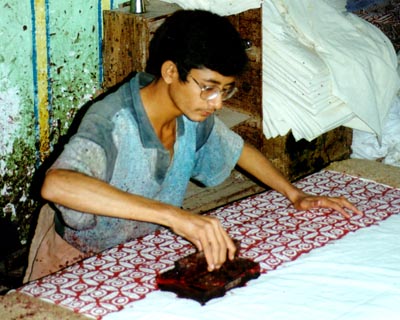INDIA
block printing on cotton, Dhamadkha, India

block printing on cotton Dhamadkha,
Gujerat India
The dying of fabrics and the printing and painting of patterns on textiles was highly developed in India from ancient times. It arose in the valley of the Indus and the coastal region of Gujerat. These areas were favourable to the growing of cotton and its citizens quickly developed the techniques of weaving, dying and printing.By the first millennium BCE, the export of cotton textiles to Egypt, the Middle East and Rome became big business; causing Pliny the Elder to complain (around 70 CE) that:
"..by the lowest reckoning, India and China and that peninsula [Arabia] take from our empire 100 million sestertii each and every year: that's how much luxuries and women cost."
Pliny was unfair to attribute this expense to women as wealthy men, then as now, indulged in many luxuries. He is correct in drawing attention to the cost; 100 million sestercii were equivalent at that time to 8,000Kg of gold! That is 3% of the entire USA production of gold in the year 2000.The Indian textile industry continues to thrive. Despite the development of modern printing techiques the old skills of block-printing are not only retained, but are enjoying a modern renaissance. Each town or village has a different style. In this photo, taken in the small village of Dhamadkha, block-printing onto cotton continues to be a prosperous activity. Intricate patterns are carved on wooden blocks which are dipped in dye and applied to the fabric. Repeated applications with slightly different patterns and dyes requires a skilled hand.
For considered help with Roman historical aspects of this page my thanks are due to:
- Bill Thayer: for matters Latin.
- Doug Smith: for matters numismatic.
Next month: an eccentric royal
Press the 'Previous' or 'Next' button to see more
Become an expert on the nuances of Gujarati blockprinting by joining our textile and craft tour later this year
....and get to know a lot about palace hotels also!
the 'Warp and Weft of India' Oct - Nov 2000.There are limited spaces for 2000 but we shall run it again in 2002.
Please contact us to go onto our mailing list.or
gain an impression of our Tibet and Nepal treks.return to the photo page from which this account originates.
or site map
revision 18 Mar 2001
http://www.greenkiwi.co.nz/footprints/photo/ph0005.htm